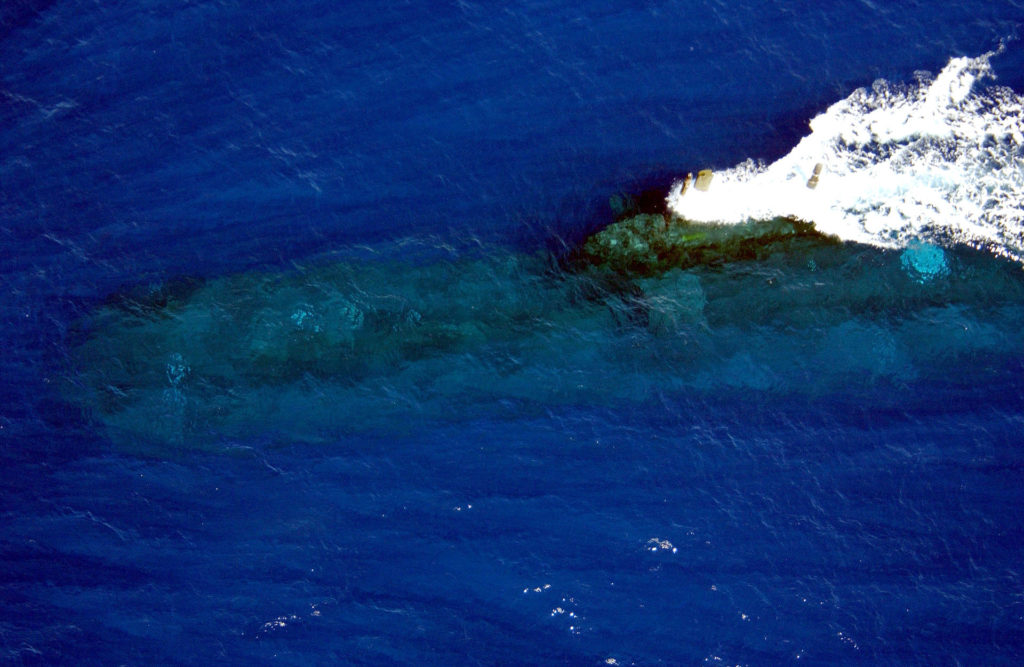Over a century ago, Admiral Sir John Fisher (1841-1920) – one of the main forces behind both the dreadnought and the battlecruiser – declared that both were obsolete. The ideal warship of the future, he insisted, was the submarine – the perfect stealth warship that could move unseen, undetected, and deliver a punch to the vulnerable underside of any surface vessel.
HMS Invincible – invented by Jack Fisher and absolutely not going to sail on a Friday 13th in 1914.
In many ways he was right. Although it took nearly half a century for submarines to make the transition from ‘submersible boats’ to viable underwater warships, submarines showed their potential well before that. German U-boats almost brought Britain to her knees in 1917, and seriously threatened British sea lanes again in the Second World War.
In the Second World War – once early torpedo trouble had been resolved – US Navy submarines were instrumental in breaking Japan’s merchant marine, severely crippling Japan’s war-making ability. They also acted as forward-rescue vessels off Japan’s coasts, plucking downed Allied airmen from the water and saving them from drowning or capture.The developments of the late Second World War period – notably in Germany – coupled with the advent of nuclear propulsion, finally combined during the first decades of the Cold War to make submarines the powerful warships Fisher had envisaged half a century earlier. But were they the perfection Fisher envisaged? When he made his prediction there was no way of detecting submarines until they surfaced; but to any measure there is always a counter-measure. Efforts to locate submarines underwater began in 1917 when the Royal Navy formed a Committee – chaired by Fisher himself – to devise an underwater location system, using sound. Among its key members was Ernest Rutherford, the Nobel Prize winning New Zealand scientist who first split the atom. The committee named the resulting system after themselves: ‘Anti-Submarine Detection Investigation Committee’ (ASDIC). But it’s better known today by its more meaningful US acronym SONAR – ‘Sound NAvigation and Ranging’.
So began the erosion of the submarine’s advantage, even as the submarine continued to develop.
USS Salt Lake City, a Los Angeles class nuclear attack boat. Public domain, via Wikipedia.
Fast-forward to the 1990s, and I was on my military journalist jag, standing behind the ‘tac rail’ of a P-3K Orion, high over New Zealand’s Hauraki Gulf, watching as the instruments picked up the tell-tale sign of a submarine. Because the journalism was secondary to my understanding of physics and engineering, I understood how this was working. It was an Australian boat, HMAS Orion – a diesel boat, which meant that, despite its age, it was still very quiet when underwater. The New Zealand aircraft had been upgraded with a computer system designed in New Zealand, and a pile of other gear – and had no problem picking up the Aussie submarine.
Writing got me some interesting places. This is me in Tom Clancy mode on a submarine hunt, Exercise Fincastle, 1994.
As it was an exercise, a brief radio exchange followed – and off the RNZAF went to do it again. And again. And again.
Now, the odds were stacked against the Australians – the exercise was in a defined area. But the boat still had to be located. And it turned out this wasn’t hard with a pattern of sonobuoys, manually ejected from a tube adjacent to the galley. The RNZAF even picked it up with the Magnetic Anomaly Detector poking from the Orion’s tail.
In the race between stealth and discovery, it seemed, submarines had come second – providing you knew where to start looking. What it meant was that in a tactical engagement – a defined and relatively constrained area, such as the perimeter of a task force or convoy – an intruding submarine would probably be found from the air or by surface ships using sonar. That detection could happen before the submarine could launch an attack of its own; and certainly would happen afterwards.
But that isn’t true of submarines quietly transiting the wider oceans, particularly the strategic missile boats. That calculation, even by the end of the Cold War, was and remains a harder one. The Cold War era Sound Surveillance System (SOSUS) is designed to pick up noises across wide areas of ocean, notably the ‘GIUK’ gap north of Britain; and other networks – including a system run by the Comprehensive Nuclear Test Ban Treaty Organisation – can pick up and generally locate noise sources across entire oceans. However, even a location defined that way still produces a relatively fuzzy result. In the early 1980s, for instance, SOSUS was reported to be able to locate a sound to within 80 km (50 miles), which still represented a significant tactical challenge. Today there are technologies that suggest submarines might be detectable with more precision across deep and wide areas, but in general, the ocean can still reasonably hide a submarine at strategic level.
So to a large extent Fisher’s prediction came true. Submarines became powerful warships that had many advantages on the back of their stealth qualities. But they weren’t perfect. No warship can be.
For more on naval history, check out my book Dreadnoughts Unleashed on Kindle. Click to buy. Also check out more of my articles such as my piece on who won the Battle of Jutland.
Copyright © Matthew Wright 2018
